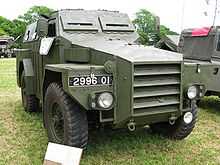Humber Pig
| Humber Pig | |
|---|---|
 Humber Pig in Parola Tank Museum | |
| Type | Armoured personnel carrier |
| Place of origin | United Kingdom |
| Production history | |
| Manufacturer | Humber |
| Number built | 1,700 |
| Variants | 2 |
| Specifications | |
| Weight | 7.5 t MK2, 6 t MK1 |
| Length | 4.93 metres (16 ft 2 in) |
| Width | 2.04 metres (6 ft 8 in) |
| Height | 2.12 metres (6 ft 11 in) |
| Crew | 2 + 8 passengers |
|
| |
Main armament | none |
Secondary armament | none |
| Engine |
Rolls-Royce B60 6-cyl 4.2 litre petrol 120 hp |
| Power/weight | 17.1 hp/tonne |
| Suspension | Wheel 4x4 |
Operational range | 400 kilometres (250 mi) |
| Speed | 64 km/h |
The Humber Pig was a lightly armoured truck used by the British Army from the 1950s until the 1990s. The Pig was also used by the Royal Ulster Constabulary (RUC) for a short period during the late 1960s and early 1970s, who painted their Pigs in Admiralty Grey, rather than the standard Army Deep Bronze Green gloss (BS381c colour 224). From 1976 all army vehicles (except public duties vehicles and some specialist vehicles) were painted NATO green (BS381c colour 285) in a matt finish paint with IRR (Infra-red reflecting) properties. The Pig became particularly well known from its presence on the streets of Northern Ireland during the worst of the Troubles.
History
The original vehicles were built by adding an armoured body to a four wheel drive 1-ton Humber truck, and were originally designed as a stop-gap until fleets of purpose-built armoured vehicles were delivered. They were sold off or put aside to be scrapped. However, as the situation worsened in Northern Ireland the vehicles proved ideal for internal security duties and were brought back into use. They have served longer than their battlefield contemporaries, the Alvis Saracen, which were not considered suitable for use in an urban environment. Legend has it that the Pig acquired its nickname because its bonnet resembled a pig's snout, it was difficult to maintain and because its driving characteristics were somewhat unrefined. As the Troubles in Northern Ireland escalated during the 1960s and 1970s the Pigs were modified with additional internal armour to create the Mark II vehicles. Further external modifications made the Pig one of the most aggressive looking military vehicles ever manufactured, and they remain an enduring symbol of the Troubles.
Variants

Production total: around 1,700
- Mark 1
- In service as FV1609, FV1611 and FV1612
- Mark 2
- In service as FV1611 and FV1612
- Extra armour for protection against armour piercing bullets and rocket propelled grenades, and carried "barricade removers" (heavy-duty bull bars) which enabled them to force their way through barricades erected in the streets.
Humber Hornet, a vehicle for carrying and launching the Malkara missile was also developed from the basic vehicle.
- Unusual, named Pigs

All developed for use in Northern Ireland:
- Flying Pig: a normal vehicle with extending riot screens either side and the roof.
- Holy Pig: rooftop hatch surrounded by perspex screen (see Popemobile)
- Kremlin Pig: wire screening for protection against rocket propelled grenades (RPG-7)
- Squirt Pig: fitted with a water cannon beside the driver for riot control.
- Foaming Pig: fitted with a foam generator to kill the blast from bombs.
- Felix Pig: modified for EOD (bomb disposal) duties.
Some vehicles have been given the machine gun turret from the Shorland Internal Security Patrol Vehicle.
See also


- Humber Hornet
- Land Rover Tangi
- List of armoured fighting vehicles
References
External links
| Wikimedia Commons has media related to Humber Pig. |
| ||||||||||||||||||||